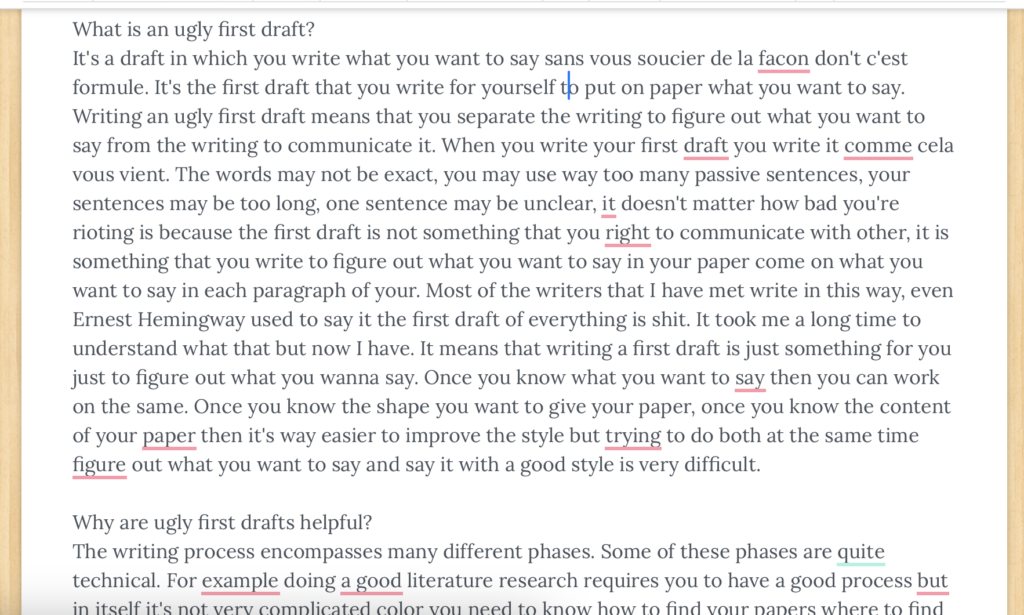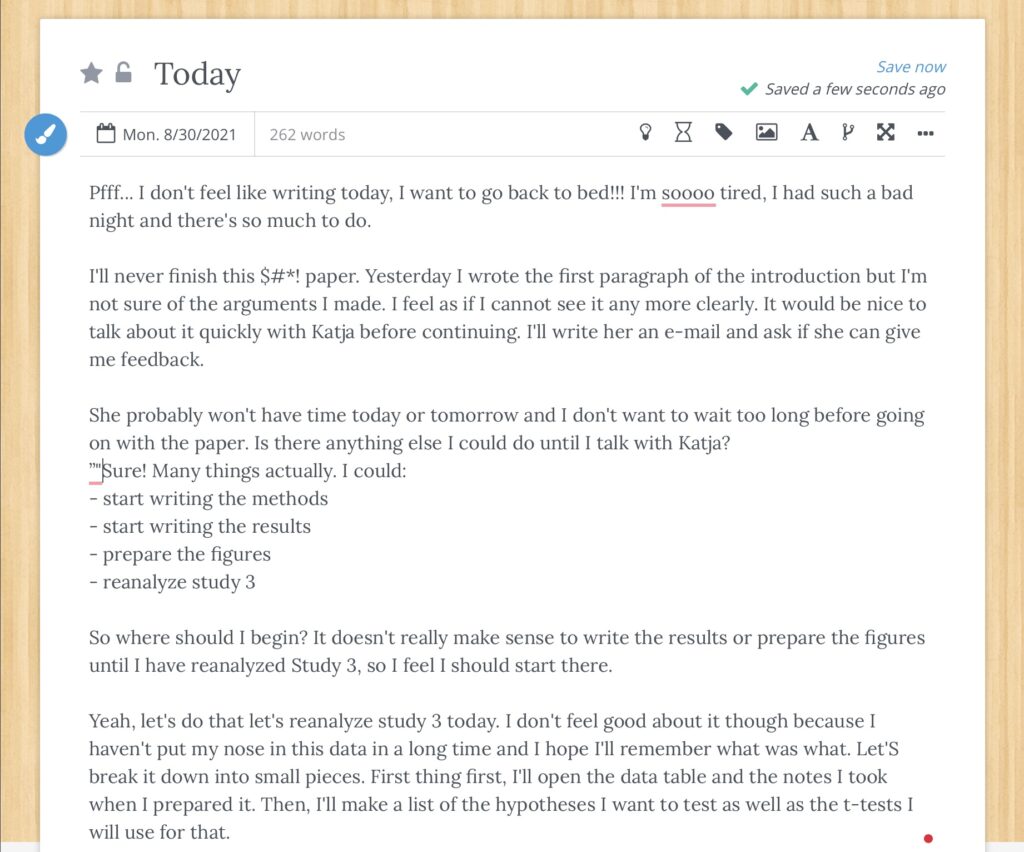In the odyssey of scientific writing, writing the first draft of a paper can be a tormented journey. In this post, I’d like to propose the idea of writing “ugly” first drafts. Precisely, you will discover what writing “ugly” means, and how it will save you hours of inefficient drafting. Moreover, I’ll share with you practical methods for getting those damn first thoughts down on paper.
Confronting my Ugly
In October 2011, I was a postdoc at the University of Cologne when I decided to finally tackle my ever-persistent writer’s block. For years, my primary strategy had been to shame myself for my inefficiency. This approach had proved highly effective in making me feel ashamed but did absolutely nothing for my actual efficiency. So, after having hit the writing procrastination wall one time too many, I had the brilliant epiphany to try something different: I would seek advice from a book on scientific writing.
On my colleagues’ suggestion, I read How to Write a Lot by Paul Silvia and resolved to follow Silvia’s wisdom to the letter: I would write every day from 10 a.m. to noon, have goals for each session, and keep track of my progress.
I kicked off my first day as a reborn non-procrastinator, elated by my new identity and anticipating a future full of academic honors and groundbreaking scientific discoveries. At 10 a.m. sharp, I opened my Word document, ready to write the first 300 words of a new paper that my supervisor and I wanted to submit to Science. I stared at the blank page and hesitantly wrote the first five words:
“Human beings are fundamentally social.”
I paused.
“Seriously? Is this banal sentence going to be the grand opening of my paper? My SCIENCE paper???”
I deleted the five words and tried a new sentence. It was even worse.
After an hour of frantically writing and deleting, exhausted and staring at an empty page instead of my intended 300 words, I realized a new approach was needed. In a desperate pivot, I decided to lean on the words of a writer wiser than me.
It took me the rest of the week to settle on a quote that was merely acceptable. I didn’t love it, but I was 1500 words behind my writing goals, and the pressure to write something was such that I didn’t care about a perfect quote anymore. And it wasn’t over. I still had the whole paper to write.
So, for the next five months, I sat every day at my desk from 10 am to noon, writing, deleting, and doubting. Eventually, a draft emerged, ready to face the world (in case you’re wondering, it got rejected by Science two hours after I had pressed the “submit” button). But, gosh, what agony did I endure to get there! And I didn’t understand why. I was a good girl; I worked daily on my paper. Why wasn’t I more productive?
Then, one day, I stumbled upon a life-saving advice that would become my writing mantra: “Write ugly first drafts.” Or, in the candid words of Ernest:

What is an Ugly First Draft?
An ugly first draft is the first materialization of your thoughts on paper without caring about expression. You write your ugly first draft as it comes to you in all its imperfections. Your ugly first draft has too many passive constructs, lengthy sentences, and it can even mix different languages. It doesn’t matter how bad it is. You don’t write it to communicate with others; you write it to figure out what you want to say in your paper.
Below, you can see the ugly first draft that I wrote for this post. If you don’t understand the first sentence, it’s normal because I mixed English and French.

Why do You Need to Write Ugly First Drafts?
Writing the first draft of a scientific article is a creative process. As such, it can only occur if you allow yourself to let the words flow as they come. But if you’re a perfectionist like me, this process can go awry. As soon as a sentence forms in your mind, your critical thinking starts to point out all its flaws. You notice that the sentence is in the passive voice, too long, too generic, too imprecise, or you start to doubt its accuracy.
The problem is that your mind can’t be simultaneously creative and critical. These imperfect sentences blooming in your mind are like a chick trying to hatch out of the egg, but every time it pokes its head out, the critical mind pushes it back in. This battle between two opposing forces slows your writing down and leads to frustration. Writing ugly first drafts is a way around this problem.
Writing ugly first drafts is a manner of separating the creative process of writing from the critical one. You allow the chick to hatch in whatever form it takes, flaws and all. And only when it has done so, do you look at it critically and start refining and improving your text.
Writing Ugly First Drafts isn’t Free-Writing
Your ugly first draft is the initial version of your paper. It has a similar structure as the final version, and it conveys the main ideas you intend to express, albeit in a clumsy and unclear manner. Free-writing is something different.
Free-writing is about transferring your thoughts onto paper without worrying about form, style, or grammar and without judging what you write. Some scientists use free-writing as a warm-up exercise to sharpen their focus. They jot down whatever pops into their heads without direction, like journaling. Others use free writing to reflect on a given topic: They ask themselves a question and then freely write down their answers (to learn more about free-writing in science, check this post).
In any case, free-writing is an excellent way to clarify and organize your thoughts, but it’s not the same as writing an ugly first draft because you don’t usually keep the outcome of your free-writing. It’s a process-oriented approach yielding texts that are often chaotic, lengthy, and repetitive. Thus, once you’ve clarified your ideas with free-writing, it’s usually best to start from scratch and compose your text.

How to Write Your Ugly First Drafts?
Having a process to write your ugly first drafts can make it easier.
1. Start with an outline
Before writing anything, you may want to create an outline of the section that you intend to write. An outline gives direction to your first draft. It also ensures that your first draft has a clear structure and a length that meets the journal’s requirements.
2. Unleash the creative beast
With a clear outline in hand, it’s time to release your thoughts and unleash your ugly first draft. Let the words come as they come, regardless of their form, style, or language (as you can see above, my ugly first drafts are a happy mix of English, French, and occasionally German).
Write one paragraph at a time and don’t edit until you finish the whole section.
3. Forget about it
When you’ve written the ugly draft of one section put it aside for a few days and forget about it. A break will help you come back to it with fresh eyes, making it easier to find areas that need improvement, as if you’re reading someone else’s work.
4. Revise
Finally, it’s time to make your ugly draft pretty. It’s time to revise. Go over what you’ve written, correct any unclear ideas, improve the style, add references, and make any other necessary changes.
Writing Ugly Drafts Takes Courage
Writing an ugly draft can be more challenging than it looks. At first, it may leave you feeling that you’re on the wrong track, especially if you’re a perfectionist. Your instinct will tell you to stop writing and start improving your sentences. But you have to learn to ignore that feeling. Your ugly draft is only the first version of your paper, and you’ll improve it soon.
I’ve been writing ugly drafts for years, but still, each time, I have the impression that any 7-year-old would be a better writer than me. I’d be lying if I didn’t admit to a residue of shame when I open the valves and let my ugly sentences flow out. But I also know there’s no getting around them. Even ChatGPT can’t save you there. If you want to share your thoughts with the world – and as a scientist you should – you first need to get them down on paper. Writing an ugly first draft requires the courage to live with your imperfections, at least temporarily.
In sum
Writing a scientific paper can be hard, especially if you’re a perfectionist. “Ugly” first drafts can be a game-changer. Putting your ideas on paper, style aside, simply gets you started.
Be courageous, give it a go! And remember: your first words don’t have to be perfect, they just have to be written.